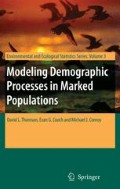Abstract
Multievent models (Pradel 2005, 2008) handle state uncertainty, and they therefore cover a range of situations like hidden capture heterogeneity and sex determination from behaviour which cannot be treated in the multistate paradigm. We introduce a new software application called e-surge, built upon the concepts developed in program m-surge (Choquet et al. 2004) to encompass this new class of capture–recapture models. It also improves on m-surge by allowing the decomposition of transitions into several steps. We present the new concepts involved, notably the event and the multistep process, and how they are implemented in e-surge. We then illustrate the use of e-surge with three examples. One example deals with breeding propensity where the breeding state cannot always be ascertained; a further deals with emigration which is considered as a two-step process (Grosbois and Tavecchia 2003) and the last one with a version of a memory model where survival can be handled directly.
Access this chapter
Tax calculation will be finalised at checkout
Purchases are for personal use only
References
Akaike H (1987) Factor analysis and AIC. Psychometrika 52:317–332.
Brownie C, Hines J, Nichols J, Pollock K, Hestbeck J (1993) Capture–recapture studies for multiple strata including non-markovian transitions. Biometrics 49:1173–1187.
Burnham K, Anderson D (2002) Model selection and inference: A practical information-theoretic approach, 2nd edition. Springer-Verlag, New York.
Cappé O, Moulines E, Rydn T (2005) Inference in Hidden Markov models (Springer series in Statistics). Springer, New York.
Caswell H (2001) Matrix population models 2nd edition., Sinauer Associates, Sunderland, MA.
Celeux G, Chauveau D, Diebolt J (1995) On stochastic versions of the EM algorithm. Technical Report 2514, INRIA Rhone-Alpes.
Choquet R (2008) Automatic generation of multistate capture–recapture models. The Canadian Journal of Statistics 36(1):43–57.
Choquet R, Reboulet AM, Pradel R, Gimenez O, Lebreton JD (2004) m-surge: new software specifically designed for multistate capture–recapture models. Animal Biodiversity and Conservation 27(1):207–215.
Choquet R, Reboulet A, Pradel R, Gimenez O, Lebreton JD (2005) m-surge: 1.8 user’s manual. Technical report, CEFE UMR 5175, Mondpellier.
Fujiwara M, Caswell H (2002) Estimating population projection matrices from multi-stage mark-recapture data. Ecology 83(12):3257–3265.
Gimenez O, Covas R, Brown C, Anderson M, Brown M, Lenormand T (2006) Nonparametric estimation of natural selection on a quantitative trait using mark-recapture data. Evolution 60(3):460–466.
Grosbois V, Tavecchia G (2003) Modeling dispersal with capture–recapture data: Disentangling decisions of leaving and settlement. Ecology 84(5):1225–1236.
Hestbeck J, Nichols J, Malecki R (1991) Estimates of movement and site fidelity using mark-resight data of wintering Canada Geese. Ecology 72:523–533.
Hines JE (1994) Mssurviv user’s manual, National Biological Service, Patuxent Wildlife Research Center, Laurel, MD 20708–4017.
Lebreton JD, Almeras T, Pradel R (1999) Competing events, mixtures of information and multistratum recapture models. Bird Study 46:39–46.
Lebreton J-D, Burnham K, Clobert J, Anderson D (1992) Modeling survival and testing biological hypotheses using marked animals: A unified approach with case studies. Ecological Monographs 62:67–118.
Lebreton JD, Pradel R (2002) Multistate recapture models: modelling incomplete individual histories. Journal of Applied Statistics 29(1–4):353–369.
MacDonald IL, Zucchini W (2000) Hidden Markov and other models for discrete-valued time series. Monographs on Statistics and applied probability. Chapman and Hall, London.
Nichols JD, Kendall WL, Hines JE, Spendelow JA (2004) Estimation of sex-specific survival from capture-recapture data when sex is not always known. Ecology 85(12):3192–3201.
Pledger S, Pollock KH, Norris J (2003) Open capture–recapture models with heterogenety: I. Cormack–Jolly–Seber model. Biometrics 59:786–794.
Pradel R (2005) Multievent: An extension of multistate capture recapture models to uncertain states. Biometrics 61:442–447.
Pradel R (2008) The stakes of models with state uncertainty. In: Thomson DL, Cooch EG, Conroy MJ (eds.) Modeling Demographic Processes in Marked Populations. Environmental and Ecological Statistics, Springer, New York, 3:781–796.
Pradel R, Johnson AR, Viallefont A, Nager RG, Cezilly F (1997) Local recruitment in the Greater Flamingo: A new approach using capture-mark-recapture data. Ecology 78:1431–1445.
Pradel R, Maurin-Bernier L, Gimenez O, Genovart M, Choquet R, Oro D (2008) Estimation of sex-specific survival with uncertainty in sex assessment. The Canadian Journal of Statistics 36(1):29–42.
Rouan L, Choquet R, Pradel R (2008) A general framework for modeling memory in capture–recapture data. Jabes, In Press.
Rouan L, Gaillard JM, Guédon Y, Pradel R (2008) Estimation of lifetime reproductive success when reproductive status cannot always be assessed. In: Thomson DL, Cooch EG, Conroy MJ (eds.) Modeling Demographic Processes in Marked Populations. Environmental and Ecological Statistics, Springer, New York, 3:867–880.
Véran S, Gimenez O, Flint E, Kendall B, Doherty P, Lebreton JD (2007) Quantifying the impact of longline fisheries on adult survival in the black-footed Albatross. Journal of Applied Ecology 44(5):942–952
White G, Burnham K (1999) Program MARK: Survival estimation from populations of marked animals. Bird Study 46(suppl.):120–139.
Author information
Authors and Affiliations
Corresponding author
Editor information
Editors and Affiliations
Rights and permissions
Copyright information
© 2009 Springer Science+Business Media, LLC
About this chapter
Cite this chapter
Choquet, R., Rouan, L., Pradel, R. (2009). Program E-Surge: A Software Application for Fitting Multievent Models. In: Thomson, D.L., Cooch, E.G., Conroy, M.J. (eds) Modeling Demographic Processes In Marked Populations. Environmental and Ecological Statistics, vol 3. Springer, Boston, MA. https://doi.org/10.1007/978-0-387-78151-8_39
Download citation
DOI: https://doi.org/10.1007/978-0-387-78151-8_39
Publisher Name: Springer, Boston, MA
Print ISBN: 978-0-387-78150-1
Online ISBN: 978-0-387-78151-8
eBook Packages: Mathematics and StatisticsMathematics and Statistics (R0)

